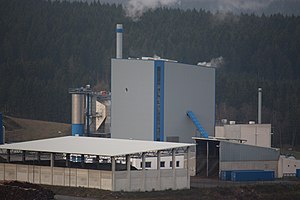Wittgenstein biomass cogeneration plant
| Wittgenstein biomass cogeneration plant | |||
|---|---|---|---|
| Biomass cogeneration plant Wittgenstein (December 2015) | |||
| location | |||
|
|
|||
| Coordinates | 50 ° 59 '46 " N , 8 ° 19' 5" E | ||
| Data | |||
| Primary energy | Bioenergy | ||
| fuel | Forest residues and landscape maintenance wood | ||
| power | 5 MW electrical + 30 MW thermal | ||
| owner | Innogy | ||
| operator | Innogy | ||
| Start of operations | 2009 | ||
| Energy fed in per year | 28 GWh | ||
| Website | www.innogy.com | ||
| was standing | January 2018 | ||
The Wittgenstein biomass cogeneration plant is a wood -fired biomass cogeneration plant in Schameder (municipality of Erndtebrück ) in the Siegen-Wittgenstein district . A pellet plant is connected to it. Together, the complex is referred to as the "Wittgenstein Double".
Construction and possible sale
Construction of the power plant began in 2008. It was completed in autumn 2009 and cost 25 million euros.
A few years later, RWE looked into reselling the power plant and the pellet plant, although RWE had taken over the last shares in the pellet plant from German Pellets on April 1, 2014. In 2016, the power plant with Innogy was spun off from RWE.
business
The power plant works by means of combined heat and power . According to a press report from 2015, around 28,000 MWh of electricity and 100,000 MWh of process heat are generated per year . For the operation of the power plant, 90,000 tons of residual forest and landscape conservation wood are burned annually. The efficiency is between 65 and 85%.
Pellet plant
There is also a pellet production plant on site. At the laying of the foundation stone in November 2009, the then District Administrator Paul Breuer said that “the most modern pellet plant in Europe” would be built. According to the environment minister of North Rhine-Westphalia, Eckhard Uhlenberg , the location is very good, because "there is the most wooded district in the industrial state of North Rhine-Westphalia ". The pellet plant was completed in the summer of 2010 for 21 million euros. A large part of the heat and electricity required comes from the neighboring biomass cogeneration plant.
The plant can produce up to 120,000 tons of pellets per year, for which 220,000 tons of round wood and sawing residues are required. Almost 75,000 tons were produced in 2017. Production is carried out continuously around the clock, seven days a week by 27 employees.
In January 2018, the employees threatened to go on strike because they would like to be paid according to the RWE collective agreement. There are big differences in income between the employees in the pellet and power plant, although the work is partly identical. Collective bargaining had already failed in the past.
criticism
It is criticized by local forest farmers and nature conservationists that the required quantities of wood are not available in the area or that their use is harmful to the local forests. Although the wood is supposed to come from a radius of 100 km, some of it has to be imported from other areas.
Web links
- Wittgenstein biomass cogeneration plant. Website of the operator innogy
Individual evidence
- ^ The Wittgenstein double: Biomass heating power plant Wittgenstein & Pellet plant Wittgenstein. In: RWE. Archived from the original on December 22, 2015 ; accessed on January 31, 2018 .
- ↑ RWE operates its own pellet plant. Selling remains an option. Siegener Zeitung, January 9, 2014, accessed December 9, 2015 .
- ↑ Electricity for 12,500 households and 80,000 tons of pellets. derWesten , March 15, 2013, accessed December 9, 2015 .
- ^ Holger Weber: Pellet factory in the Wittgenstein industrial park . In: Siegener Zeitung. Wittgenstein edition . November 9, 2009.
- ↑ a b NRW Pellets employees threaten to go on strike . In: Siegener Zeitung. Wittgenstein edition . January 30, 2018.
- ↑ Ute Schlapbach: Where does the wood for the biomass cogeneration plant come from? derWesten , March 1, 2010, archived from the original on March 6, 2016 ; Retrieved December 9, 2015 .
- ↑ Large biomass cogeneration plant is changing our forest. (PDF; 2.9 MB) In: Nature and Environment in Siegen-Wittgenstein. NABU , 2009, accessed December 9, 2015 .


